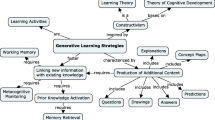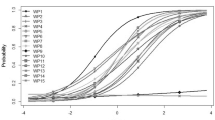Abstract
This study explored progression of students’ level of reasoning and generalization in numerical and figural reasoning approaches across grades and in different pattern generalization types. An instrument that included four figural patterns was administered to a sample of 1232 students from grades 4 to 11 from five private schools. The findings suggest that there was progressive development in the level of reasoning and generalization in each reasoning approach across clusters of grades. The level of reasoning and generalization in figural approach was higher than that for numerical approach in each grade. In addition, the level of reasoning and generalization for each approach and in each grade was not limited to one level but to several levels. The type of generalization influenced the progression of students’ level of reasoning and generalization in each approach.







Similar content being viewed by others
References
Biggs, J., & Collis, K. (1982). Evaluating the quality of learning: The SOLO taxonomy. New York: Academic.
Biggs, J., & Collis, K. (1991). Multimodal learning and the quality of intelligent behavior. Intelligence: Reconceptualization and measurement (pp. 57–76). Hillsdale: Lawrence Erlbaum Associates Broadway.
Collis, K., Romberg, T., & Jurdak, M. (1986). A technique for assessing mathematical problem-solving ability. Journal for Research in Mathematics Education, 17(3), 206–221.
El Mouhayar, R., & Jurdak, M. (2015). Variation in strategy use across grade level by pattern generalization types. International Journal of Mathematical Education in Science and Technology, 46(4), 553–569.
El Mouhayar, R., & Jurdak, M. (2016). Variation of student numerical and figural reasoning approaches by pattern generalization type, strategy use and grade level. International Journal of Mathematical Education in Science and Technology, 47 (2), 197–215.
Healy, L., & Hoyles, C. (1999). Visual and symbolic reasoning in mathematics: Making connections with computers. Mathematical Thinking and Learning, 1(1), 59–84.
Glaser, B. G., & Strauss, A. L. (1967). The discovery of grounded theory: Strategies for qualitative research. New York: Aldine De Gruyter.
Küchemann, D. (2010). Using patterns generically to see structure. Pedagogies: An International Journal, 5(3), 233–250.
Lannin, J., Barker, D., & Townsend, B. (2006). Algebraic generalisation strategies: Factors influencing student strategy selection. Mathematics Education Research Journal, 18(3), 3–28.
McClelland, J. L. (2010). Emergence in cognitive science. Topics in Cognitive Science, 2(4), 751–770.
Jurdak, M. & El Mouhayar, R. (2014). Trends in the development of student level of reasoning in pattern generalization tasks across grade-level. Educational Studies in Mathematics, 85(1), 75-92.
Radford, L. (2003). Gestures, speech, and the sprouting of signs: A semiotic-cultural approach to students’ types of generalization. Mathematical Thinking and Learning, 5(1), 37–70.
Radford, L. (2008). Iconicity and contraction: A semiotic investigation of forms of algebraic generalizations of patterns in different contexts. ZDM, 40(1), 83–96.
Radford, L. (2010a). Algebraic thinking from a cultural semiotic perspective. Research in Mathematics Education, 12(1), 1–19.
Radford, L. (2010b). Layers of generality and types of generalization in pattern activities. PNA, 4(2), 37–62.
Radford, L., Bardini, C., & Sabena, C. (2007). Perceiving the general: The multisemiotic dimension of students' algebraic activity. Journal for Research in Mathematics Education, 507–530.
Rivera, F., & Becker, J. R. (2008). Middle school children’s cognitive perceptions of constructive and deconstructive generalizations involving linear F patterns. ZDM Mathematics Education, 40(1), 65–82.
Rivera, F. D. (2010). Visual templates in pattern generalization activity. Educational Studies in Mathematics, 73, 297–328.
Stacey, K. (1989). Finding and using patterns in linear generalizing problems. Educational Studies in Mathematics, 20(2), 147–164.
Strauss, A., & Corbin, J. (1998). Basics of qualitative research techniques. Thousand Oaks, CA: Sage publications.
Author information
Authors and Affiliations
Corresponding author
Rights and permissions
About this article
Cite this article
El Mouhayar, R. Trends of progression of student level of reasoning and generalization in numerical and figural reasoning approaches in pattern generalization. Educ Stud Math 99, 89–107 (2018). https://doi.org/10.1007/s10649-018-9821-8
Published:
Issue Date:
DOI: https://doi.org/10.1007/s10649-018-9821-8




